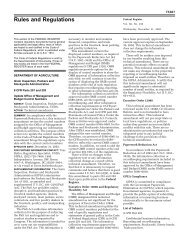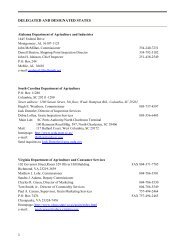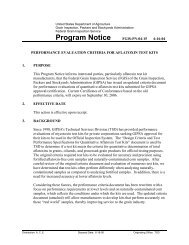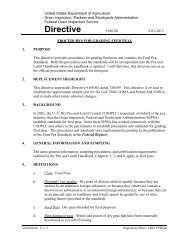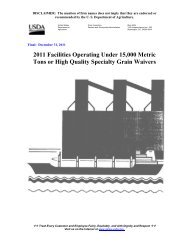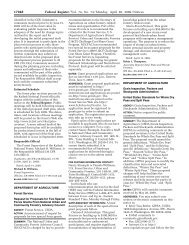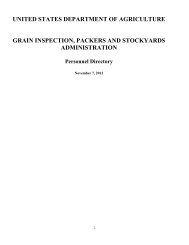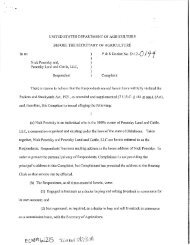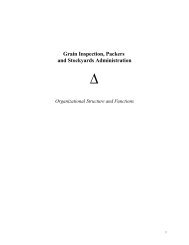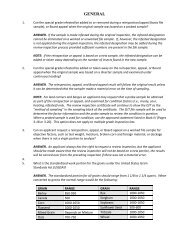Assessment of the Cattle and Hog Industries Calendar Year 2000
Assessment of the Cattle and Hog Industries Calendar Year 2000
Assessment of the Cattle and Hog Industries Calendar Year 2000
Create successful ePaper yourself
Turn your PDF publications into a flip-book with our unique Google optimized e-Paper software.
(table 12). Packers purchased 8.5 percent <strong>of</strong> <strong>the</strong>ir hogs in <strong>2000</strong> using a fixed price tied to<br />
a futures market price, up from 2.9 percent in 1997. Purchases using a fixed price tied to<br />
a feed ingredient price increased to 12.3 percent in <strong>2000</strong>, up from 5.3 percent in 1997. 89<br />
Table 12.—Percentage <strong>of</strong> U.S. hogs procured through various pricing methods<br />
Pricing method 1997 Jan. 1999 Jan. <strong>2000</strong><br />
Spot market purchases 43.4<br />
Percent<br />
35.8 25.7<br />
Total non-spot market purchases 56.6 64.2 74.3<br />
Fixed price tied to a futures market price 2.9 3.4 8.5<br />
Fixed price tied to feed price 5.3 9.8 12.3<br />
Window, risk sharing 3.1 4.6 4.6<br />
Formula o<strong>the</strong>r than above 39.1 44.2 47.2<br />
O<strong>the</strong>r (packer owned, internal transfer) 6.1 2.3 1.7<br />
Source: Grimes, Glenn <strong>and</strong> Steve Meyer, “<strong>2000</strong> <strong>Hog</strong> Marketing Contract Study,” University <strong>of</strong> Missouri <strong>and</strong> National Pork<br />
Producers Council., March 7, <strong>2000</strong>.<br />
Ledger Contracts<br />
Marketing contracts containing ledger accounts (ledger contracts) were first widely used<br />
in <strong>the</strong> 1990s. Ledger contracts establish a minimum floor price <strong>and</strong> a maximum ceiling<br />
price for a producer’s hogs. These contracts effectively loan packers <strong>the</strong> difference<br />
between <strong>the</strong> market price <strong>and</strong> ceiling price when prices are above <strong>the</strong> ceiling price, <strong>and</strong><br />
loan producers <strong>the</strong> difference between <strong>the</strong> market price <strong>and</strong> <strong>the</strong> floor price when prices<br />
are below <strong>the</strong> floor price. Packer loan balances are reduced when market prices are<br />
below <strong>the</strong> ceiling <strong>and</strong> producer loan balances are reduced when <strong>the</strong> market price is higher<br />
than <strong>the</strong> floor price. When hog prices are very low, as was <strong>the</strong> case in December 1998<br />
<strong>and</strong> early 1999, large negative balances (owed by producers to packers) accrue.<br />
Producers with negative balances at <strong>the</strong> end <strong>of</strong> a contract term must ei<strong>the</strong>r pay <strong>the</strong> ledger<br />
balance, or extend <strong>the</strong> contract in an attempt to reduce <strong>the</strong> ledger balance. Ledger<br />
contracts may allow some producers to keep operating longer during periods <strong>of</strong> low<br />
prices. Producers carrying ledger balances may require longer time periods to terminate a<br />
contract agreement, <strong>the</strong>reby limiting opportunity to raise hogs under contract for ano<strong>the</strong>r<br />
packer.<br />
Packer Control <strong>of</strong> <strong>Hog</strong> Quality<br />
Packers develop distinct st<strong>and</strong>ards for hogs targeted at specific markets. Packers<br />
shipping pork to foreign countries, for instance, may require a specific color or pH level<br />
in <strong>the</strong> meat. Packers marketing meat products to health-conscious consumers may have<br />
additional st<strong>and</strong>ards. To meet <strong>the</strong>se st<strong>and</strong>ards, packers place specific requirements in<br />
marketing contracts. 90 Packers identify producers to participate in long-term contracts<br />
based on <strong>the</strong> quality <strong>of</strong> hogs previously delivered by <strong>the</strong> producer. Specific genetics <strong>and</strong><br />
89 Grimes, Glenn <strong>and</strong> Steve Meyer, “<strong>2000</strong> <strong>Hog</strong> Marketing Contract Study.” University <strong>of</strong> Missouri <strong>and</strong> National Pork Producers<br />
Council, March 7, <strong>2000</strong>.<br />
90 Kenyon, David E. <strong>and</strong> Wayne Purcell, Price Discovery & Risk Management in an Industrialized Pork Sector, Department <strong>of</strong><br />
Agricultural <strong>and</strong> Applied Economics, Virginia Polytechnic Institute <strong>and</strong> State University, October, 1997.<br />
26



